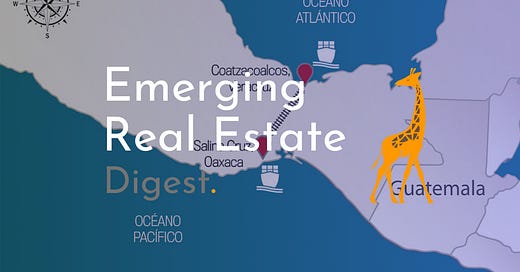The Time Has Come for Mexico's Interoceanic Corridor
Mexico's ambitious project to provide a faster and cheaper alternative to the Panama Canal will require $50 billion of investment capital transforming the underdeveloped southern part of the country.
The Interoceanic Corridor is a railway and highway system linking two ports across the narrowest part of Mexico. The infrastructure improvement works are ongoing and include:
Modernizing the ports of Coatzacoalcos, Veracruz and Salina Cruz,
Creation of 10 industrial parks (costing $1 billion each and on 200-400 hectares),
Upgrading the Isthmus of Tehuantepec Railway to handle high-speed,
Expand the Minatitlan and Ixtepec airports,
Installation of gas pipelines and fiber optic connections, and
Doubling of the highway size from two to four lanes.
Once complete, the Interoceanic Corridor will be a cheaper and faster shipping option than the Panama Canal. Geopolitically, it represents an opportunity for the Americas to turn the tide on China’s dominance of Latin America which is expressed in many ways including its dominance of the region’s ports. Even the Panama Canal, built and paid for by the Americans, is now largely controlled by the Chinese.
You may be asking, “why not just build a canal through Mexico?”
Admittedly, a canal would remove the necessity to unload the cargo, take it by rail or road to the other ocean, then reload onto another vessel. But the cost to realize the engineering marvel would be too great. The distance of 300 miles of land between the oceans is six times the distance of the Panama Canal which is 45 miles long. The Suez Canal is longer at 120 miles, but it was dug out through flat desert, whereas the corridor goes through mountains, jungles, as well as many tribes, communities and municipalities all with different customs and interests in developing the region. To cross the Isthmus of Tehuantepec the ships would need to be raised ten times what is the case at the Panama Canal.
Brief History of The Corridor
The Corridor was first established by the Spanish in the early-1800s to ship products to Spain from the Philippines and Mexico, both colonies at the time. Railway lines were laid in 1907 by a British entrepreneur, Lord Cowdry, and the railway ran profitably until America opened its Panama Canal in 1914. Before this, James Buchanan Eads, an American millionaire engineer, intended to build a railroad connecting the Gulf of Mexico and Pacific Ocean and had the government’s support to carry on with the works. When he died in 1887, the idea faded away.
The Americans first intended to build a canal through this section of Mexico, and even got so far as signing a treaty to that effect with Mexico called the McLane-Ocampo Treaty. The Panama Canal was ultimately chosen because America would have sovereignty over the development, and it was quicker and cheaper to bring it to fruition.
Why it Matters
(1) Beginning of a $50 Billion Investment Wave. Advantages gravitate towards early investors in the case of strategic projects, assuming of course that they ultimately succeed. There are opportunities now for investors, miners, and manufacturers in the Americas to participate in the Interoceanic Corridor now and on favorable terms. Mexico can’t do this alone.
(2) Tax Breaks and Development Capital Availability. The Mexican government is offering tax breaks through “Free Trade Zones”, and the Inter-American Development Bank has prioritized $2.5 billion to fund companies locating operations in the Interoceanic Corridor. The tax breaks currently on the table for qualified investors include no taxation on income for three years, followed by a discount in taxation of 50% the following three years. Depreciation is allowed to be accelerated during the first six years. Business conducted in the Corridor will be exempt from VAT taxation, and new firms can reclaim VAT paid on purchases outside of the region for four years.
(3) Panama Canal is Saturated. Ships often wait 6 days to pass through the Panama Canal and the recent drought almost forced the Canal to temporarily shut down. Experts predict that the Interoceanic Corridor will be cheaper and faster, once fully operational, than the Panama Canal for most shipments.
(4) More Than Logistics. The Panama Canal offers a solution for ships wishing to pass quickly to and from the Pacific and Atlantic Oceans. Mexico’s Interoceanic Corridor will offer that, plus more. Goods can be unloaded at one of the ports and processed further in one of the ten major industrial hubs envisaged along the corridor. This part of Mexico contains much of the country’s natural resource reserves, including 80% of known oil, and 57% of known gas reserves.
(5) Cure for Left-Wing Politics in Mexico. The notion of redistribution of wealth has many political proponents given the region’s long-term history of poverty and underdevelopment. Creating jobs, and involving the south in the nearshoring boom, will make it easier for Mexico to have future governments focused on pro-market policies aimed at advancing the country, not dividing it up and redistributing.
Contribution: Thanks to David M. Krakoff for the contribution and frequent discussions about the Interoceanic Corridor. David has a diverse, 35+ year career as a CEO, President and senior executive with several world class, global companies, such as TOTO, Kaiser Aluminum, AB Electrolux, Southwire Company, Vitromex USA and Momentum Textiles and Wallcovering. David has worked in most of the world’s major and emerging markets and has driven industry-leading results in the organizations he has led.







